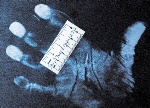
Future Forensics: Recovering Fingerprints from Fabrics
Forensic experts at the University of Abertay Dundee and the Scottish Police Services Authority (SPSA) are leading the way in the research of new ground-breaking forensic techniques within the field of fingerprints.
The new research seeks to recover fingerprint ridge detail and impressions from fabrics -- a technique that has up until now proved difficult. It is the first time in more than 30 years that fingerprints on fabrics have been a major focus for research and the team have already had a number of successes.
A technique known as vacuum metal deposition (VMD) that uses gold and zinc to recover the fingerprint mark is being investigated as part of the research project. VMD is a highly sensitive technique already used to detect fingerprint marks on smooth surfaces, such as carrier bags, plastics and glass.
The current research study is exploring its use in the examination of clothing and the potential value it could bring to a police investigation.
"The research uses fine layers of metals to display fingerprints people may have left on fabrics, something which is far harder to do with soft surfaces," said Joanna Fraser, a forensic sciences researcher at the University of Abertay Dundee. "The technique has been around since the 1970s and is used on many surface but was never widely used on fabrics.
"We take these fabrics, place them in a vacuum chamber, then heat up gold to evaporate it and spread a fine film over the fabric. We then heat up zinc, which attaches to the gold where there are no fingerprint residues. This helps reveal the fingerprint - where contact has been made we see the original fabric, where there was no contact we're left with the grey colour of the metal film.
"One way of explaining it is like a photographic negative, where colours show up as their opposites. Here the fingerprint ridges show through as clear fabric, but where there are no ridges we see the distinctive grey colour of the metal.
"Previously it had proved difficult to reveal a clear fingerprint on fabric, but we've shown that this is now possible. This is great, but the challenge is to develop this further and confirm its effectiveness."
"Fingerprints have been used as a means of identification for over 100 years but recovering fingerprints from fabrics has always proven to be fairly difficult, " said Paul Deacon, fingerprint unit manager at the Scottish Police Services Authority and one of the experts on the project. "We wanted to change that.
"The research is still in its early stages but we are starting to see results. We have shown that fabrics with a high thread count are best for revealing a print and have recovered identifiable fingerprints on a number of fabrics including silk, nylon and polyester."
Only 20 percent of the public are classed as "good donors" for leaving fingerprints, so while the success rate is still low for recovering a full fingerprint from items of clothing, the researchers have had great success in revealing the shape of a handprint on a number of fabric types.
"Such an impression could help the police piece together a timeline of events and could be used to provide evidence in cases where someone was pushed, or grabbed, in a particular area of their clothing," Deacon said. "For example, an impression of a palm print on the back of someone's shirt might indicate they were pushed off a balcony, rather than jumping. Fingerprints left on fabric and other surfaces can leave DNA traces, so it can also help forensic scientists to visualise the best area to target on an item of clothing to recover DNA evidence."
"Used on its own fingerprints and impressions recovered on fabrics will not necessarily convict a criminal but used alongside other evidence it will present a more robust case to the court," said Tom Nelson, director of SPSA Forensic Services. "I am determined that we continue to balance the consolidation of the core forensic support we provide to the police and the Crown, with new innovations and techniques. This is just one such innovation we are pursuing as we strive to ensure that forensics makes an even greater contribution to convicting the guilty and protecting the public."